I'm fresh back from a weekend in sunny South Florida, where I spent four days at
Langerado in its new location at Big Cypress. It was a great trip, with a (mostly) outstanding lineup, fantastic performances, and a secluded site. But was it as green as the organizers had promised when I
interviewed them last month?
The short answer: not really. But that doesn't mean that they gave up on greening, or were greenwashing the festival. It just means that this was a festival that is trying to be green, not a green festival. It was hard to tell what was going on behind the scenes. More to the point, it seemed at times as though the organizers were a bit over their heads in a festival of this size, and while scrambling to keep up, the greener details got lost in the shuffle.
So what were the green aspects?
To start, there was Greenerado, envisioned as a green educational "ecovillage" located at the center of the festival, complete with a small stage. It was a nice idea, but this village was really just a couple of eco-themed merch tents--organic skin care (free sunblock, though-nice move!) and bamboo shirts, along with a "sustain your soul" tent I never quite got the gist of and a sparsely populated silent auction.
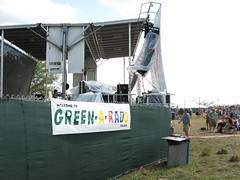
There was also a tent set up for topics with titles like "Living the Scene: Sustainability in Music, Activism, and Politics of Sustainability," but when I showed up, there was no one there. I managed to find Bryan Birch of ZeroHero, the event's greening consultant, who told me that they'd had trouble getting artist participation. This shouldn't be too surprising--given the stellar lineup and the crowds, I'm sure the artists had other things on their mind. I know the fans certainly did. The non-profit tents seemed to be limited to an Audobon Society exhibit on the Corkscrew Wildlife Sanctuary and a tent dedicated to destroying Florida Power and Light. The inside of this second tent had a collection of photcopied handouts with titles like "Work Sucks" and "Cell Phones Suck." The first one, at least, seemed to resonate with the crowd.
On the other hand, the Greenerado stage was bigger than the solar stage at Bonnaroo and had legit performances by really good bands. I found myself there at least a half-dozen times over the course of the weekend, not for the green aspect but for the music. If the organizers can beef up the content at Greenerado in future years and keep the quality of music on stage there the same, they should be able to really draw some people in to the greener side.
Outside of Greenerado, there were recycling bins at every trash station, which the crowd seemed to be using as they were intended. And Bryan told me that they'd managed to fuel every single generator at the show with 100% biodiesel, which we later clarified to mean 100% B20 (20% biodiesel). While there's a growing backlash against certain forms of biodiesel, it's still better to get vendors accustomed to it now and open up the door for truly sustainable biofuels that are coming down the pipe, like algal biofuels.
During my pre-show interview, I'd been told about the "positive legacy program." If there was any work done on this front to leave Big Cypress and the Seminole Tribe better off than they started, it wasn't well publicized. Similarly, there was supposed to be work done on "sustainable product sourcing." Outside of the compostable (but not actually composted) cups at the VIP beer tents and the ludicrous water pouches described below, I'm not sure what the sustainable products were.
On the waste management front, Clean Vibes was out in force doing its usual bang-up job of keeping the festival grounds picked up. There were recycling bins at every trash station, and it seemed like most festival goers were using them properly. But I didn't get any trash or recycling bags when I walked in off the bus, and several of the folks who drove in told me they didn't get them, either. The result was that the camping areas were pretty well trashed when I left on Monday morning. I couldn't find any evidence of a composting program. I did see a couple of people walking around with compostable beer cups, which were apparently in use at the VIP tent, but without composting facilities these don't do much good.
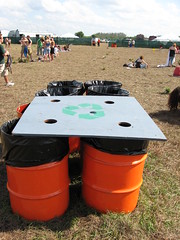
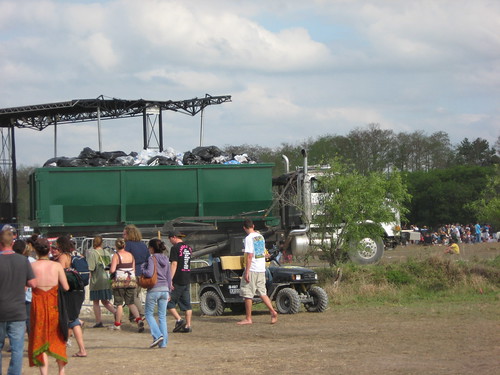
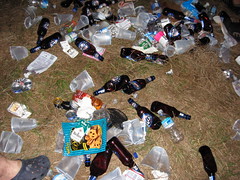
Speaking of composting, the festival toilets were standard composting toilets, not the new composting toilets
springing up in Europe and Australia. Hopefully we'll see a lot more composting coming to US festivals in the next couple of years. A location like Langerado--normally used for pasture, with thin soil, would be a perfect spot to compost a mix of food scraps, compostable plates, etc., and
humanure. And quite frankly, just about anything would be preferable to the current festival toilet situation.
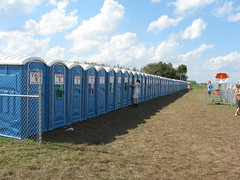
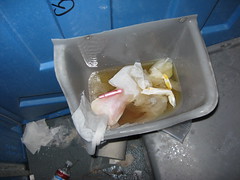
Food was standard fare--I saw nothing touted as organic. There was definitely nothing local, not even fresh citrus products. But food wasn't the real issue. The biggest logistical problem at the festival was the lack of water. To be blunt, the organizers completely dropped the ball on this one. In the camping area, there was only one tanker truck of water that I could find, and it wasn't well set-up for washing--just a bunch of taps over what soon became a muddy mess. Both Saturday and Sunday mornings, as everyone went to get cleaned up, the tanker ran dry. On Sunday morning, I saw a handful of people on top of the tanker. They had opened up the top and were hanging down by their knees, trying to fill up their nalgene bottles from the puddles at the bottom. One of them nearly fell in when his buddy released his ankles to retrieve the nalgene.
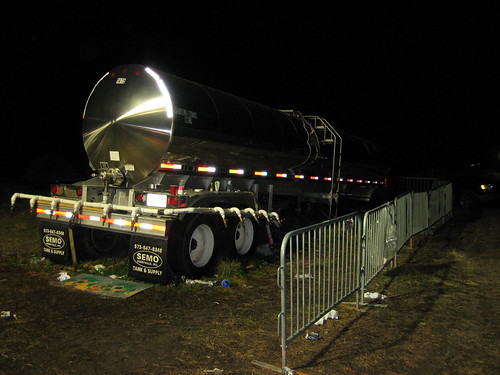
The water woes were even worse inside the festival area. The only water for sale--including at the general store--was $3 a pint pouches that looked like bigger versions of Capri Sun. No gallon jugs, no cases of bottles, nothing. We weren't allowed to bring in water except in small sealed bottles, and there was NO free water inside the venue. This is a practice that should be outlawed at all big outdoor events. Forcing people to pay $3 for a pint of water--$24 a gallon--when they're standing around in the sun all day is criminal. Langerado was very proud of the special "low-energy" pouches of glacial melt water they trucked in from Utah. That's straight-up greenwashing, I say--trucking water 2000 miles is not "low-energy," and not giving people water at an outdoor festival in 80 degree heat is just wrong. Everyone at the festival was exceedingly upset about this, especially those of us who flew in to take the shuttle and didn't have the opportunity to stop and buy supplies, like cases of water and beer ($5 a can for Miller Lite).
That brings me to another problem with the greening of the festival--traffic. The site is fantastic, but it's 14 miles down a road off the main freeway with no other access to the festival site. The inevitable traffic jam was over 4 hours when I arrived on the shuttle, and I heard unconfirmed rumors that on Saturday the line was backed all 14 miles up to Alligator Alley. The festival had a chance to really promote some great alternatives to traffic with the shuttle service it offered ($60 round trip), but it dropped the ball. Flying in was a miserable experience--we got off the plane and onto the bus, with no stops for food or supplies. The buses waited in the same traffic, although we pooled our funds and bribed our bus driver $250 to drive illegally down the left lane (into oncoming traffic) and get us in more quickly. We were dropped off in a muddy field with no direction and just pitched our tents at the first spot that looked good. With limited baggage, none of us had any of the amenities--like food, campstoves, or coolers--that make camping at a festival bearable. And with no car to secure our goods, theft was a problem. I had my tent entered, and although nothing was stolen from my tent, my neighbors were relieved of their bags--including clean clothes and plane tickets--while they watched the closing set on Sunday night.
Flying in isn't great for the environment, but people are going to continue to fly to festivals, so organizers should at least make an effort to get them out of rental cars. I would have gladly paid another $40 or more on top of the $60 bus fare to get a decent tent site, close to the action, with shared coolers and barbecues and some sort of secure storage area. We should have had the option to stop and buy supplies or buy supplies at reasonable rates on site. Our bus drivers should have been instructed to take a back route or jump the line--for every 50 people in a bus, that's 12-20 cars that aren't in line, so busing in people makes much more sense, and bus passengers should be rewarded for getting out of their cars, not punished. Coming in by plane and bus should be an almost VIP-like experience. After all, the festival organizers are making a profit on the bus tickets, can squeeze more people into the camping area without cars, and will save money and headaches on traffic management. Environmentally, buses could save thousands of gallons of gasoline and reduce the associated air pollution over the masses of idling cars they replace and by reducing the overall traffic flow.
In summary, it wasn't bad, but it was a long way from being a truly green show. The organizers really seem to want to be greener, they just haven't figured out their strategy just yet. If they can repeat the amazing lineup, get the same quality of performances and fine-tune their logistics, this show has serious potential. Hopefully they will live up to that potential in a sustainable way. My overall green grade: C
Labels: festivals, jason, Langerado, water







